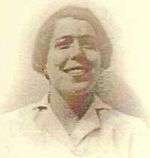Magda Bošković
Magda Bošković (3 November 1914 – 1942) was a Croatian communist, Partisan and member of the women's rights movement.
Magda Bošković | |
|---|---|
 | |
| Born | 3 November 1914 |
| Died | Spring 1942 (aged 27) |
| Nationality | Croat |
| Alma mater | University of Zagreb |
| Occupation | Clerk |
| Relatives | Dragutin and Ivanka (née Szarvas) Bošković (parents) Maja Bošković-Stulli (sister) |
Bošković was born in Osijek to a Jewish family of Dragutin and Ivanka (Janka) Bošković.[1] Her father was clerk at the bank, and her mother was a housewife. Bošković was raised with younger sister Maja. In 1923 she moved with her family to Zagreb, Croatia. Bošković finished elementary school and gymnasium in Zagreb. She later graduated from the Faculty of Economics and Business, University of Zagreb. In 1932 Bošković was among the founders of Marxist group at the University of Zagreb. In 1934 she joined the Young Communist League of Yugoslavia and was elected as a board member of the student section in the Women's movement. Bošković also worked on the accepting the Yugoslav volunteers who went to Spain to join the International Brigades in fight against Spanish Nationalists. She was an editor of the papers "Naše novine" (Our papers) and "Ženski svijet" (Women's world). After graduation Bošković worked as a clerk at the sawmill company "Neuschloß, Schmidt und Marchetti" (later "Našička d.d."). She worked in Đurđenovac and later in Zagreb. Bošković was active in the Women's rights movement across Croatia. After the Invasion of Yugoslavia in 1941, Bošković joined the resistance movement in Croatia. She was a member of the Women's Antifascist Front of Croatia and council member of the "Društvo za prosvjetu žena" (Society for education of women). In 1942 Bošković was arrested and imprisoned at Savska cesta prison. Later she was deported to Stara Gradiška concentration camp where she was killed by Ustaše.[2][3] Her parents were also killed during the Holocaust,[4][5] while only her sister managed to survive.
Bibliography
- Snješka Knežević, Aleksander Laslo (2011). Židovski Zagreb. Zagreb: AGM, Židovska općina Zagreb. ISBN 978-953-174-393-8.CS1 maint: ref=harv (link)
- Romano, Jaša (1980). Jevreji Jugoslavije 1941-1945: žrtve genocida i učesnici narodnooslobodilačkog rata. Beograd: Jevrejski Istorijski Muzej, Saveza jevrejskih opština Jugoslavije.CS1 maint: ref=harv (link)
- Kraus, Ognjen (1998). Dva stoljeća povijesti i kulture Židova u Zagrebu i Hrvatskoj. Zagreb: Židovska općina Zagreb. ISBN 953-96836-2-9.CS1 maint: ref=harv (link)
References
- Snješka Knežević (2011, p. 83)
- Jaša Romano (1980, p. 340)
- "Magda Boskovic". Pages of testimony by Maja Bošković-Stulli (sister). Yad Vashem.
- "Dragutin Boskovic". Pages of testimony by Maja Bošković-Stulli (daughter). Yad Vashem.
- "Ivanka Boskovic". Pages of testimony by Maja Bošković-Stulli(daughter). Yad Vashem.